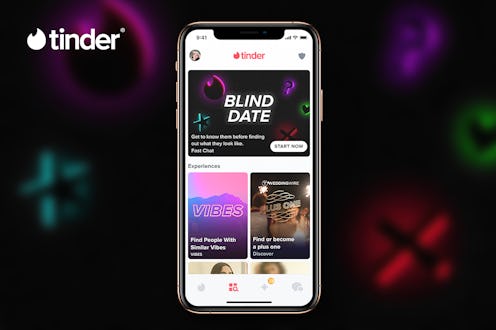Dating
Tinder Just Dropped A New Blind Date Feature
Think Love Is Blind, but you don’t have to get married after four weeks.

If online dating is starting to feel like the same old thing, Tinder has a new feature that’s going to bring some excitement. On Feb. 11, 2022, the popular dating app announced it added a Blind Date option to its Explore page. With Tinder’s Blind Date, users can now experience what it’s like to go on a date with an absolute, total stranger, but from the comfort of their own home. Even more exciting, you won’t know what they look like until you finally match. If you hate all the back and forth messaging that never leads to any actual dates, this is a feature you may want to try for yourself.
“We’ve all seen the mix of anticipation and excitement going on a blind date brought some of our favorite movie or TV characters, and we wanted to recreate that experience for today’s generation with the Blind Date feature,” Kyle Miller, VP of Product Innovation at Tinder, said in a press release. “There's something really special about letting conversation introduce someone’s personality, without the preconceptions that can be made from photos.”
Sound like something you may be interested in trying? Here’s all the info you need to know about Tinder’s Blind Date.
What Is Tinder’s Blind Date?
In order to use the Blind Date feature, users will log on to the Explore section of Tinder from 6 p.m. to midnight local time. If you aren’t familiar with Explore, it’s basically a hub full of features like Hot Takes, Vibes, Fast Chat, and Swipe Night, which give users more opportunities to meet people in more fun and interactive ways like in-app events. For instance, Swipe Night was an experience where users could choose their own adventure and get matched based on the decisions they made throughout the “story.”
Blind Date falls under the Fast Chat feature that gives users a chance to message someone for a short time before deciding to swipe left or right. The Blind Date feature works in a similar way, except you’ll be chatting with someone whose profile and photos will be hidden at first. It was inspired by IRL blind dates, where you don’t know who you’re going out with (or what they look like) with until you meet face-to-face. In this case, Tinder acts as the friend setting you up. It makes conversation and chemistry a deciding factor in whether you like someone or not.
According to Tinder, early testing found that those using Blind Date made 40% more matches than they did use the regular Fast Chat feature. So it appears that Tinder users are open to seeing where it goes with people who may not be their usual type.
How Does Tinder’s Blind Date Feature Work?
Tinder users will first start by answering a short series of icebreaker questions in order to be paired with people who may be a good match. They’ll be asked to answer multiple-choice prompts like, “It’s OK to wear a shirt ... times without washing it” or “I put ketchup on ...” From there, you’ll enter a timed chat where you won’t know anything about the person you’re talking to other than their answers to multiple-choice questions. If you want, you can even use these prompts to get a conversation started.
Once the timer runs out, you can choose to “Like” the other person, which will then reveal their Tinder profile. If you choose to swipe left, you’ll get paired with someone new and start the whole thing over again. What’s more, the feature works as a blind date-speed dating hybrid. If there’s really nothing there, you only have 30 seconds with that person before you move on.
Why Don’t I Have Blind Date On Tinder?
If you’re on Tinder and you can’t find Blind Date, first make you have the latest version of the app. It’s a good idea, in general, to make sure Tinder is always up to date so you don’t miss any other new features or updates. Once you have the newest version, you can either exit the app and open it again, or turn your phone off completely and log back in.
Most importantly, be sure you’re on Tinder from 6 p.m. to midnight local time. That’s when the Blind Date feature is available.
This article was originally published on